Aussie Football Rules
When it comes to sport, the outright winner of popularity in the land down under is Australian Rules football. This mega-famous sport, also widely known as Aussie footy or just Aussie Rules, is a type of football resembling rugby and American football. It involves passing a special ball throughout the field using any part of their body.
As much as it’s fun to watch, Australian Rules betting is hugely present among Aussie punters. The AFL, the most-watched and wagered-on league, gathers thousands of sports bettors who place money line, over/under, prop, parlay bets, and many other types.
Keep reading and learn the basics of Aussie rules football with our team at OnlineBettingAUS.
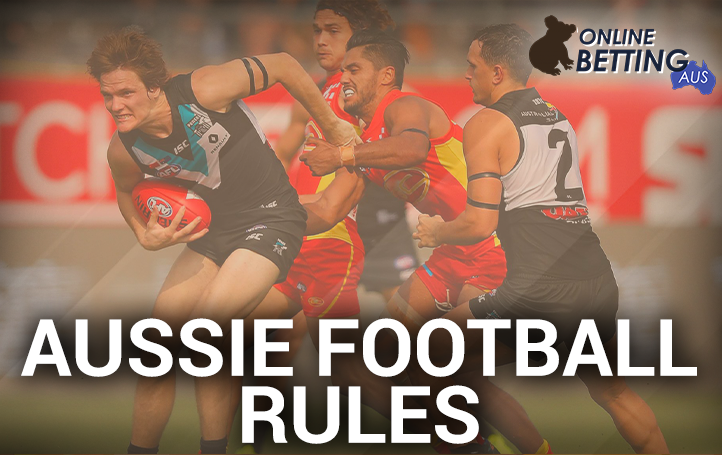
Aussie Football Brief History
The beginnings of Australian Rules football are still unclear, but it is known that the sport set its root in Melbourne in the middle of the 19th century.
It is believed that it all began in 1857, when Tom Willis, who is nowadays considered as one of the several founders of Australian football, came up with a new collection of rules for this winter sport, with the purpose of keeping the cricketers in good shape throughout the cold months. After this, on the 7th of August in 1958, the Melbourne Football Club was formed.
As years went by, the sport gained in popularity and began to prosper. Consequently, in 1866, the rules were updated and refreshed and that’s when club competitions started to be organised.
Thirty years later, in 1896, the first clubs to compete in the freshly-established Victorian Football League were Carlton, Collingwood, Essendon, Fitzroy, Geelong, Melbourne, St Kilda, and South Melbourne.
The league was renamed in 1997 with its new name being Australian Football League, and a total of 16 clubs were competing.

Comparing Australian Football vs. Rugby vs. American Football
Aussie football might look exactly the same as American football or Rugby for some amateurs, but there are some notable differences. These sports differ in many segments, some of them being the rules of footy, the size of the ball, the location of the sport, the number of players, etc.
Check the table below for all the differences among these seemingly similar sports.

| Field shape | Number of Players in a Team | Number of Substitutes in One Match | Location | Duration | Ball Shape and Size | |
|---|---|---|---|---|---|---|
| Australian Football | Oval-shaped | 18 | 3 | Australia | 80 minutes – four quarters lasting 20 minutes each | Oval-shaped but smaller and more rounded than rugby. |
| American Football | Rectangular | 11 | Unlimited | USA | One hour – four quarters lasting 15 minutes each | Oval-shaped |
| Rugby | Rectangular | 15 | 7 | Worldwide | 80 minutes – two halves lasting 40 minutes each | Oval-shaped |
Rules of Aussie Football
Many Australians decide to try out Aussie Rules betting, but in order to place smart bets, one should know the basic rules of Australian Football.
- A team competing in this sport consists of 22 players, 18 of which are actively playing on the field while others are substitutes.
- There are a total of 7 umpires present during a game – three are field, two are boundary, and two are goal umpires.
- The duration of an Australia footy game is 80 minutes. Four quarters are played for 20 minutes each, plus additional time compensation for pauses during the play, which is called ‘time-on.’
- At the end of each quarter, teams switch the ends and kick the ball in the other direction.
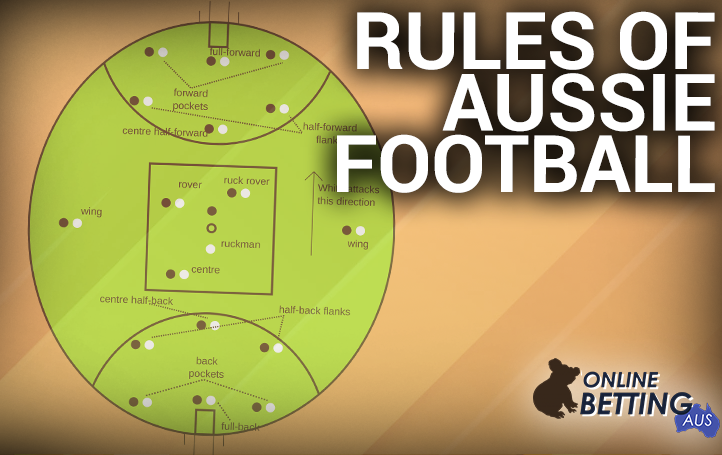
The Main Goal of the Game
The final purpose of this football Australian game is to score as many points as possible by shooting goals and scoring points in different ways. Normally, the team that has more total points than their competitor is the winner.
A goal is not the same as a point, and the biggest difference is that the goal is worth six points, while points can only be scored one by one. To score a goal, a play must kick the ball through the two goalposts, which are the tallest posts in the middle. For a goal to be valid, the ball mustn’t be touched by anyone else.
On the other hand, a simple point or a so-called ‘behind’ can be scored in several ways. The team scores a point if:
- Another player touches the ball on its way to pass the goal-scoring line;
- The ball hits one of the goalposts or just passes over it.
- The ball passes between a goalpost, which is the tall one, and a point post, which is the short one.
- A player from the defence willingly takes the ball behind their own goal in order to avoid the risk of the other team scoring a goal.
During the play, the results are written in the following way – 5.10.40, which means the team has scored 5 goals, 10 points, and 40 overall points.

Basic Rules
The beginning of a game of Aust rules football is simple – one of the umpires holds the ball in the centre of the field, and he bounces it from the ground. Immediately after, two players from each team called the ‘ruckmen’, run for the ball and have to pass it to other team members. The same beginning method is used after each team scores a goal.
The handling of the ball is in a special way – players cannot kick it but rather ‘handball’ it, meaning that they can hold it in one palm and then punch it with the other. Kicking is also allowed only if it’s kicked more than 15 metres and then caught by another teammate who hasn’t touched it while in the air. He calls a ‘mark’, and a free kick is scored.
Running with the ball is allowed but can’t be longer than 15 metres. Contact among players is also allowed via a method called ‘hip and shoulder.’
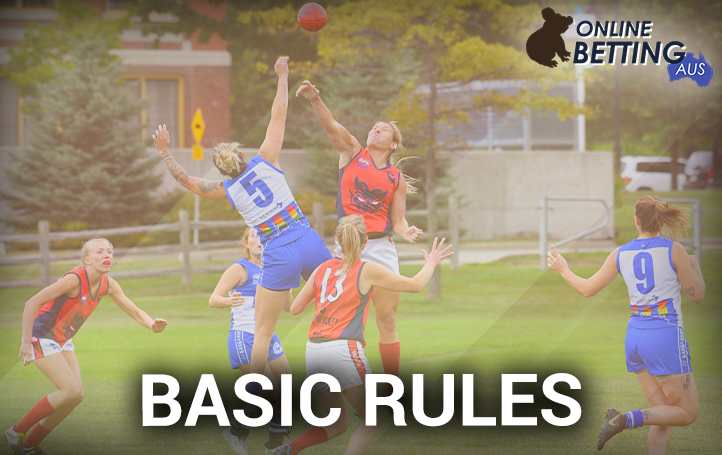
Unacceptable behaviour results in a free kick awarded to the other team, and this can be done for the following reasons.
- Holding a player – It isn’t allowed to hold or turn over an opposition player if they don’t possess the ball.
- From the neck above – Players cannot tackle one another above the height of the shoulders.
- Sticking with the ball – If you are tackled while holding the ball and don’t let go fast, you will be penalised.
- Back Pushing – Pushing an opponent from the back is penalised.
- Ball Throwing – You can only handball the ball; you aren’t allowed to throw it.
- Out on the full – Before it crosses the boundary line, the ball must bounce before. If it doesn’t bounce, a free kick penalty is awarded.
- On purpose – Deliberately kicking the ball out of bounds isn’t permitted.
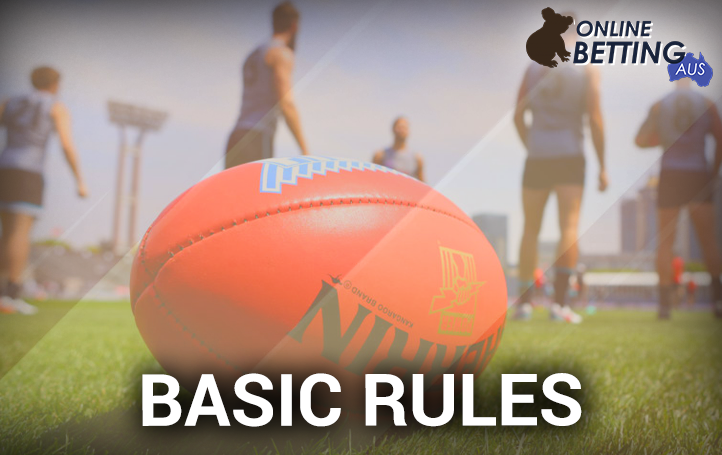
Participating Countries
Even though it originates and is actively played in Australia, Aussie rules footy is played in many other countries too. The AFL has made official partnerships and has agreed with 16 other governing bodies from other countries for the Australian Rules Football to be played there. Consequently, there are at least 20 other leagues worldwide competing in Aussie football.
While Australia is the only place where the sport is professionally played, these are the following affiliations that are in place in other countries.
- AFL Canada;
- AFL Scotland;
- ARFL Ireland;
- Danish Australian Football League;
- AFL England;
- AFL New Zealand;
- AFL Wales;
- Nauru Australian Football Association;
- AFL Japan;
- USAFL;
- AFL PNG;
- AFL Germany;
- AFL Samoa;
- AFL Middle East;
- AFL South Africa;
- Tonga Australian Football Association.

Field & Ground Markings
The rules of Australian football state that the field should be in an oval shape with a grass surface. The field dimensions can vary between 135 to 185 metres, measured between one goal post to another, and 110 to 155 metres, measured from one wing to another. The field can actually vary in shape a little bit, some being longer and more narrow, while others are more circle-shaped, which mostly depends on the construction location.
When it comes to the ground, various markings are present there, and they all signify the following things.
- Straight and 19.2 metres long are the two goal lines, located one at each end of the field.
- Arched around the field edge and linking the two goal lines are two boundary lines.
- Around the goal lines, there are two goal squares and their dimensions are 6.4 x 9 metres.
- The centre of the ground is reserved for the central square, whose dimensions are 50×50.
- Placed inside the central square are two circles with a diameter of 3 and 10 metres, with a line dividing them as seen from the wing side.
- Placed at every end between the boundary lines are two circular lines which are 50 metres long and are placed at a distance of 50 metres measured from the centre goal line.

How to Play Aussie Football?
We have broken down the rules of footy for our fellow readers, and now we’ll continue sharing info about how to play it in additional detail.

Starting the Match
The beginning of the match is signalised by the umpire, who bounces the ball from the ground going high in the air. When the ball falls down, two opposing players (the ruckmen) go in for the catch. This whole process is called a ‘ball-up’.
If, after the bounce, the ball happens to go out of boundary lines, the returning of the ball to the field is the responsibility of a boundary umpire. He turns his back to the field and tosses the ball back in the field without watching. This process is called a ‘throw-in.’

Moving the Ball
The movement of the ball is strictly regulated in Australia footy, and only strictly predetermined methods are allowed when it comes to passing the ball. Players are allowed only to kick or handball the ball but never throw it in any other way. Kicking is also called footballing, while handballing can be done with a fist. Holding on to the ball isn’t allowed, and once a player has it, they need to get rid of it via two of the previously mentioned ways.
Once a player has the ball in their hands, they can run a maximum of 15 metres holding it, after which they need to bounce or touch the ball on the ground. Failure to do so will result in a free kick for the opposition team. If the player is thrown over or tackled by an opponent, they need to let go of the ball as quickly as possible because if they hold on too long, the same penalty of a free kick is awarded to the other team.
Finally, tackling can only be done between the shoulders and knees; any other form of throwing the player down is also penalised.

Marking
A ‘mark’ is claimed when a player catches the ball which has been flying in the air for over 15 metres, without touching the ground, and it has been thrown by another player.
When a mark is claimed, the match is stopped, and the player gets ready to kick the ball precisely from that place where he claimed the mark; during this time, he cannot be tackled. However, the player doesn’t have to kick; he can also choose to continue the match normally after marking if they wish so.

Match Duration
The duration of the whole match in Aussie Rules football is 80 minutes, divided into four quarters, each lasting 20 minutes. There are official timekeepers who are dealing with time management during the game because the clock is often stopped. The clock pauses when a player gets tackled to the ground when a goal is scored when a ball-out is needed, and for time-off too.
A break of six minutes is held between the first and second and the third and fourth quarter, while the break between the second and third quarter is longer – twenty minutes.

Australian Football – Players & Positions
There are a total of 24 players that make up the team of an Aussie rules footy club. Eighteen of them are in-game, while the other three are substitutes. When it comes to substitutes, they are allowed throughout the entire game but need to be completed via a predetermined interchange gate placed near the bench.
The 18 players that are inside the field are arranged in five lines, with three players on each. Depending on their field position, they are deemed right, left, or centre in reference to the attack direction.
The five lines are occupied by three players in the following positions:
- Full Forwards;
- Half Forwards;
- Centre Line;
- Half Backs;
- Full Backs.
The Ruckmen, Ruck-over, and Rover, are the names for the followers, which are the players who follow the ball. Even though players start at assigned positions on the field, during the game, they are allowed to move everywhere. Another difference between Australian Rules football and football is that in the prior, there is no goalkeeper.
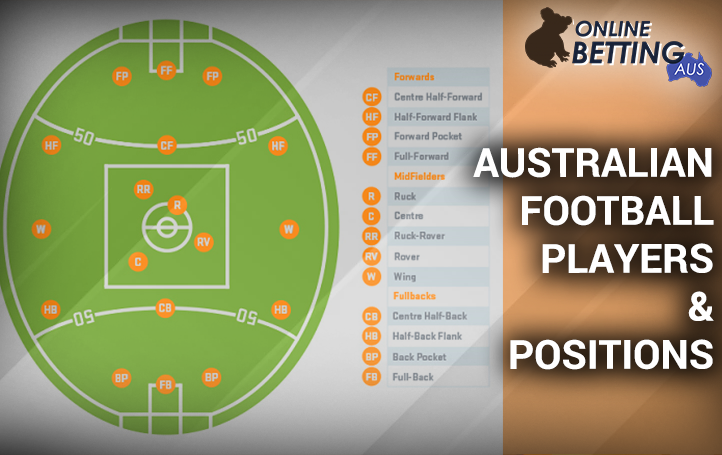
Player Positions and Their Purpose
Now that you know a thing or two about the positions of the players, let’s elaborate on who does what during a game of Aussie footy.
- The players whose purpose is to attack the goal and cross the ball in the opponent’s area are called Full Forwards.
- Those who also attack the goal and transfer the balll in the other area but also plan the scoring shots are the Half Forwards.
- Same as half forwards, Centre Line players set up shots for a score but also take the ball from the back line.
- Those who are keeping the ball in the area and passing it to the front are the Full Backs.

Umpires in Australian Football
There are a total of 7 umpires who judge and control the game on the field. Three of them are central or so-called field umpires, two of them are boundary, and the last two are goal umpires.
The field or central umpires have the major task and role during the game. They are designated to start and end the match, reward free kicks or marks during the game and make sure that all other minor rules of the game are respected.
The boundary umpires focus more on the outer side of the field. Their task is to get the ball back to the centre after a team scores a goal and determine whether a ball is in or out of the boundary lines during the match. Moreover, they also have to notify if a player has illegally entered the central square.
The last two goal umpires concentrate on the goals that are scored. They notify everyone if a goal is scored by waving two flags or if it’s just a behind, by waving one flag. Prior to the goal umpire prescribing the goal to the team, the field umpire has to indicate to him that everything was done right on the field.
Once a decision has been made by a field umpire, it cannot be changed. The only exception to this rule will be if a player or other team official breaks another rule in the meantime. On the other hand, a decision of a goal umpire can sometimes be considered more important than the decision of the boundary umpire related to the proximity of the goal area. This would be done by the goal umpire tapping his hand on the chest, a signal for field umpires.

Australian Football – Handballing & Kicking
There are only two allowed ways to dispose of the ball when playing Australian Rules football – handballing and kicking. Let’s take a closer look at each.
Since throwing the ball is strictly forbidden, the only movement allowed with a hand is handballing, and it is done when kicking is impossible. This is done by holding the ball in one hand, making a fistbump with the other, and then punching the ball with the fist while the other hand just holds it. Marking cannot be awarded when the ball was handballed, and any player that catches the ball after 15 metres in the air has to continue the match as before by disposing of the ball.
This movement is strictly controlled, and failure to do it in the proper way always results in a reward for the other team – a free kick. A free kick is awarded when
- The hand that you hold the ball with moves in the direction towards which you plan to punch the ball in.
- If the hand you plan to punch with isn’t in a clenched fist, but you rather use an open hand.
- The holding hand throws the ball in the air before you punch it.
- Handballing the ball straight to a teammate.

When you use the foot to move the ball, that’s a movement called kicking, and this is the most used disposing method in this sport. There are lots of various kicking styles, and we’ll present the most common ones in the list below.
- Drop Punt – When a player drops the ball from his hands to the ground, almost touching it, then quickly kicks it with the purpose of rotating backwards while flying.
- Torpedo Pun – When the ball is kicked at an angle that allows it to spin via its long axis.
- Checkside Punt – Known also as a banana punt, the ball, when kicked, curves away from the body, veering towards the direction in accordance to the food a player uses to kick.
Free kick – A penalty for one of the teams; there are no particular restrictions when it comes to kicking during a free kick.

Scoring
Scoring a goal worth six points is done when the ball passes between the two goalposts. It doesn’t matter whether the ball passes in the air, bounces off the ground, or passes over the height of the goalposts – it is still a goal in any way. A player can score a goal when they kick the ball by foot only, and no other body parts are allowed to transfer the goal between the two goalposts.
The umpires can signalise a behind in the upcoming situations.
- When the ball goes between a goalpost and a behind post, regardless of the height.
- If the ball touches any of the goalposts.
- If the ball was hit by any other part of the player’s body, except the foot.
- If the ball came in contact with any part of the defendant player’s body before passing between goalposts.
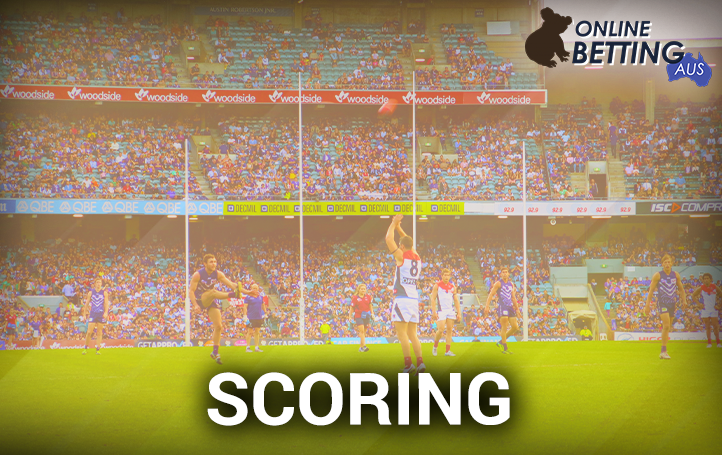
Australian Football League
Punters who check Aussie Rules betting odds at online bookies usually focus on wagering on the Australian Football League – the major and most-watched league in Aussie Rules throughout the island’s territory.
Established as the Victorian Football League (VFL), today, AFL is the primary professional league of Australian football, which also serves as the governing body of this popular sport and is also devoted to updating or keeping the rules in line.
AFL organises the Australian Football International Cup every three years, which is an international sports competition in this sport coordinated by the league’s officials. Worldwide teams can participate in this Cup, which is the most prominent Australian Rules football event ever since 2002.

